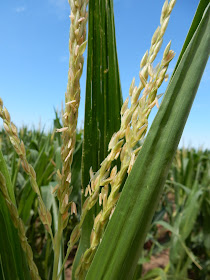When I got my farm permit, I drove the wheat trucks to the Iuka Co-op. Our hired man, Ed, was my patient navigator the first year. He taught me the fine points of waiting in line, unrolling the tarp, how to dump the truck and instructions in the fine art of elevator etiquette. But, after that, I made dozens of trips to the elevator during wheat harvest each year.
When Randy and I were first married, I worked at The Hutchinson News, so I didn't drive the truck, except on weekends. After I "retired" from that job and the kids got a little older, I was back in the driver's seat again.
However, I've never driven our semi. This is the second wheat harvest we've had it. I know I could learn. But we've had a hired man available to do it, so my job has transitioned to go-fer and cook.

The other evening, after one of our rain delays during harvest, our hired man wasn't back yet, so Randy asked if I'd like to go with him as he drove the semi with a load of wheat to Zenith.
It's definitely a different perspective, viewing the familiar Zenith Road from a loftier perch.
We arrived at our destination - our favorite prairie skyscraper.
Randy unrolled the tarp.
He pulled the semi onto the scales at the co-op office, where they weigh the loaded truck. With the orange probe, they get a sample of the wheat and test for quality, including weight, moisture, protein and foreign matter.
 |
| This was taken in 2015. This trip, I was inside the truck cab. |
Through the rearview mirror, we could see that they wanted us to take the truck to location "B" - inside the elevator.
These elevators were designed long before there were big semi trucks. It's a tight squeeze.If I were the driver, I would much rather dump at the outside pit, location "C."
 |
| Photo from 2015 - the outside dump location |
 |
| Photo from 2015, showing co-op guys opening the hatches. |
With the grain unloaded, Randy pulled back onto the scales for an empty weight. We also pick up the ticket which gives a record of how much wheat we delivered that trip and its quality.
Then, it was back to the field to fill 'er up again.
The farmer or landlord pays a storage fee to the co-op based on the amount of time the grain was stored before being sold. Then, it belongs to the co-op. When the co-op sells it, most is trucked out of the elevator to the buyer. (In the past, rail travel helped move a lot of grain, too, but most of it is trucked these days, at least in this area.)
FYI: When I pulled up a blog post from last year, I saw that wheat was $5.15 on June 23. Wheat closed at $3.15 on the board at Zenith yesterday.
Thankfully, we were able to start cutting again yesterday afternoon after our Tuesday rain delay. We had to move to a different location. It is a slow process, since the wheat is down fairly badly and he's still having to battle some mud. But the wheat yields are still above average, though quality has suffered with the rains.
Still, we're glad to be back at it! Every swath puts us a little closer to done.
















































